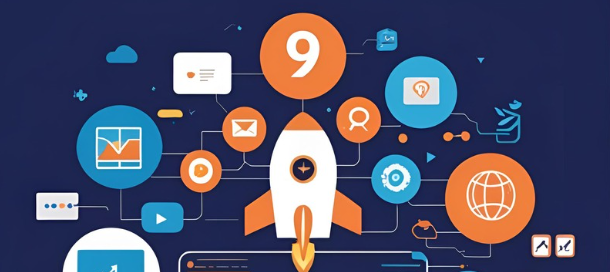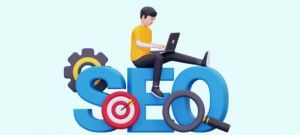In this digital world, marketing strategies have changed so much that it is converted into newspaper ads and billboards to online marketing. And if we want to succeed in today’s competitive business world then we have to adopt core digital marketing strategies that will effectively reach, engage, and convert our audience into customers.
This blog has top 9 core digital marketing strategies, each one is very essential for building a strong online presence. if we understand these strategies, it can help us in a startup, a small business, or a global brand and it will also help us to choose the right strategy for our business/ brand.
1. Search Engine Optimization (SEO)
Search Engine Optimization (SEO) is a strategy that helps us to optimize our website fully and its content to improve the visibility of our brand in organic (unpaid) search engine result pages. When users search for information, products, or services online especially on Google (which is the first largest search engine)- SEO helps our website to appear as high as possible in the results.
The higher our website ranks, the more chances that users are going to click on it. This will lead to increased traffic, better brand exposure, and a higher chance of conversions (sales, sign-ups, etc.).
Why is SEO Important?
- Over 90% of online surfing/ searches begin with a search engine.
- Websites that are shown on the top of the first page of Google, get over 75% of clicks.
- The most cost-effective way to grow your online presence is organic search traffic.
Whether we are running a blog, e-commerce store, or business website, SEO is very important to drive loyal and long-term traffic.
Key Components of SEO:
1. On-Page SEO:
This refers to all the steps/ action that can be taken directly on the website to improve the position in the rankings.
It includes:
- Keyword Optimization: Using same intent keywords naturally in titles, headings, and content.
- Meta Tags: Well-written title tags and meta descriptions that include keywords and encourage users to click on our website .
- Headings (H1-H6): Well – organized structure of headings for better understanding.
- Content Quality: Unique, useful, engaging, and keyword-rich content.
- Image Optimization: Proper image file names, alternative texts, and sizes.
2. Off-Page SEO:
In this we take actions outside of our own website to improve our rankings on pages.
It includes:
- Backlinks: Links from other websites that point to our site (especially from reputed websites like wikipedia).
- Social Sharing: When people share our content on platforms like Facebook, LinkedIn, etc.
- Brand Mentions: When other sites mention our brand (without a link).
3. Technical SEO:
In this, backend elements help search engines to crawl and index our website effectively.
It includes:
- Mobile-Friendliness: Websites should be responsive and easy to use on smartphones. It should not include horizontal swiping.
- Page Speed: Fast-loading pages improve user experience and rankings.
- Crawlability: Make sure Google bots can access and read our site.
- Secure Website (HTTPS): It improves trust and tells users that it is a secure website.
- XML Sitemap & Robots.txt: Help search engines to navigate our site properly.
Pros of SEO:
- 1. Free & Continuous Traffic
- 2. Long-Term Growth
- 3. Higher Brand Credibility
- 4. Better User Experience
- 5. Increased Sales & Conversions
Cons of SEO:
- 1. Slow Results
- 2. Highly Competitive
- 3. Constant Algorithm Changes
- 4. Needs Skill & Strategy
- 5. Ongoing Maintenance
SEO Tools You Can Use:
- Google Search Console
- SEMRush / Ahrefs / Ubersuggest
- Yoast SEO (for WordPress)
- PageSpeed Insights
2. Social Media Marketing (SMM)
In social media marketing, we use apps like Instagram, Facebook, LinkedIn, and many others like these to promote our products and services so that our target audience can know about us, they will get to know what we are providing. Then they will show interest and become our customers.
In this:
- We run ads on Google and social media platforms.
- We post content regularly.
- We make a closed community and keep them engaged.
- We offer giveaways to our audience.
- We do collaborations with influencers to promote our products and services.
- We can even measure our performance and take further steps according to the result.
Popular platforms used in SMM include:
- Instagram
- Facebook
- LinkedIn
- X (Twitter)
- YouTube
- Pinterest
- Snapchat
Key Activities in Social Media Marketing:
1. Content Creation & Posting:
Creating and posting content regularly is very important in Social Media Marketing. This includes:
- Images and graphics
- Short videos and reels
- Stories and live sessions
- Polls, quizzes, and Q&A posts
- Educational carousels
2. Community Management:
This is about engaging with our audience through:
- Replying to comments and DMs
- Responding to reviews and mentions
- Liking, resharing, and following users
3. Paid Advertising:
Paid ads help us to increase our reach. Each platform offers advertising tools:
- Facebook & Instagram Ads
- LinkedIn Sponsored Posts
- X (Twitter) Promoted Tweets
- YouTube Video Ads
4. Influencer Collaborations:
Doing Paid collaboration/ partnership with influencers.
Types of influencers:
- Nano (1K–10K followers)
- Micro (10K–100K)
- Macro (100K–1M)
- Mega (>1M followers)
Pros of Social Media Marketing:
- Increased Brand Awareness
- 2. Cost-Effective Marketing
- 3. Better Customer Engagement
- 4. Boost in Sales and Leads
Cons of Social Media Marketing:
- Time-Consuming
- 2. Negative Feedback
- 3. Algorithm Dependency
- 4. Risk of Burnout
Top Social Media Tools for Marketers:
- Canva
- Buffer/ hootsuite
- Later
- Buzzsumo
- Meta ads manager
3. Content Marketing
Content Marketing we create valuable and relevant content to keep our target audience engaged.
Unlike traditional marketing, content marketing does not directly sell a product or service and it provides informative and educational content that builds trust with our customers over time.
Popular Formats of Content Marketing:
1. Blogs and Articles
Written content and then posted on a website that educates, informs, or entertains.
Example: “Master in email marketing- a complete guide!”
2. Infographics
Visual content that simplifies complex information into an easy-to-understand graphic.
Example: A graphic showing the “Buyer’s Journey in just 4 Steps”
3. Podcasts
Audio content where experts discuss topics or interview with guests
Example: A weekly digital marketing free ai tools podcast
6. E-books
In-depth downloadable guides on a specific topic.
Example: “2025 Ultimate Guide to Social Media Marketing”
Pros of Content Marketing:
- Boosts SEO and Website Traffic
- 2. Establishes Brand Authority
- 3. Supports the Buyer’s Journey
- 4. Cost-Effective Over Time
- 5. Drives Engagement and Community
Cons of Content Marketing:
- Slow Results
- 2. Requires Labor
- 3. Requires Consistency
- 4. Difficult to Measure Direct ROI
- 5. Content Saturation
Top Tools for Content Marketing:
- Grammarly
- Canva
- semrush/ Ahrefs
- Google docs
- WordPress
4. Email marketing
In Email marketing, we send emails to a list of our customers to promote products, share news or new launches to educate them. It is a direct form of marketing that allows businesses to communicate personally and professionally with our target audience.
Whether it’s a welcome message, a discount offer, a newsletter, or a survey, emails help us to stay top-of-mind and build customer loyalty.
Pros of Email Marketing:
- Cost-Effective
- 2. Personalized Communication
- 3. High ROI (Return on Investment)
- 4. Easy to Track and Measure
- 5. Automation and Scalability
- 6. Direct Access to Your Audience
Cons of Email Marketing:
- Spam Issues
- 2. Design and Content Challenges
- 3. List Management
- 4. Data Privacy Regulations
- 5. Unsubscribes and Bounces
Types of Email Marketing:
- Welcome Emails
- Newsletter Emails
- Lead Nurturing Emails
- Confirmation Emails
- Dedicated Emails
- Invite Emails
- Promotional Emails
- Survey Emails
- Seasonal Marketing Emails
5. Pay-Per-Click (PPC) Advertising
In this, we run ads on platforms like Google and when someone clicks on our ad, we have to pay money to Google for every click.
Platforms include Google Ads, Bing Ads, Facebook Ads, Instagram Ads, and more.
Types:
- Search Ads
- Display Ads
- Shopping Ads
- Retargeting Ads
Pros of Pay-Per-Click (PPC) Advertising:
- Immediate visibility
- Highly targeted
- Easy tracking
Cons of Pay-Per-Click (PPC) Advertising:
- Costly for competitive keywords
- Click fraud
- Short-term
6. Affiliate Marketing
In this, we promote other products and then we’ll get some commission. For eg- if we put a link of some product in our youtube video and then someone buys that product from our link within 24 hrs then we’ll get commission.
Popular Channels:
- Blogs
- YouTube reviews
- Coupon or deal websites
- Influencer links
Pros of Affiliate Marketing:
- Low risk
- Scalable
- Reaches new audiences
Cons of Affiliate Marketing:
- Less control
- Commission eats into profit
- Fraud risk
7. Mobile Marketing
In this, we do promotions through SMS or apps as most of the users use mobile only. So it is important to do mobile-friendly marketing.
Strategies:
- SMS campaigns
- Mobile apps
- Location-based ads
- Mobile-optimized emails and websites
Pros of Mobile Marketing:
- Personal reach
- High open rate
Cons of Mobile Marketing:
- Privacy concerns
- Design limitations
- Permission needed
8. Video Marketing
In this, we make videos of our products or services showcasing all the features. This method makes sure that the user is encouraged to buy the product.
Types:
- Explainer videos
- Testimonials
- Live streams
- Tutorials and demos
Pros of Video Marketing:
- Highly engaging
- Boosts conversion rates
- Great for SEO
Cons of Video Marketing:
- Time and cost intensive
- Large file sizes
- Skill required
9. Landing Page Marketing
A landing page is a single – purpose web page focused on one goal- usually converting visitors into customers. It’s often used for ads, email campaigns, or product launches.
Examples:
- Free trial signups
- Ebook downloads
- Webinar registrations
- Limited-time offers
Pros of Landing Page Marketing:
- Focused message
- A/B testing
- Measures performance clearly
Cons of Landing Page Marketing:
- Needs skilled design and copy
- High bounce rates if not optimized
- Time-consuming setup
Which Strategy Should We Choose?
Here’s a general recommendation:
- For brand awareness: Start with SEO, SMM, and content marketing.
- For leads and conversions: Use landing pages, PPC, and email marketing.
- For wider reach: Combine affiliate and mobile marketing.
- For engagement: Add video marketing and social media.




